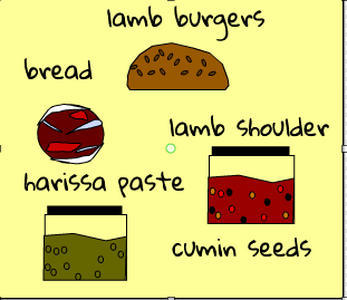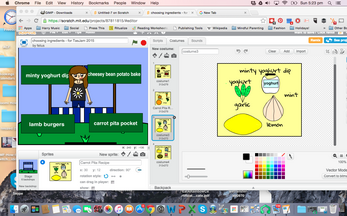Dinner Quest
'Dinner Quest' Shopping Game
Team
John Dalton, Parent, Mentor, developer, project manager, wrangler,
Bernd Wechner, Parent/ Mentor, developer, project management, preliminary open source software research, recipe scanning and edit, scrolling engine programming, quiz engine integration
Bin Wang, Parent/ Mentor, developer, project management, quiz research, quiz text edit insertion and programming
Ruth Howard, Parent/ Mentor, educator, project management, recipe research and selection, Eat a Rainbow concept research and references, programming, rainbow quiz questions
Gypsy Anna Polacheck game stall graphics, food graphics, voice over, recipe scribe, recipe graphics, recipe programming
Harry Howard, music x 2 themes, voice overs, programming, initial aerial map view of market not used in the end, house graphic with mama, stall holder graphic, voice over and script
Oliver Dalton, food graphics, voice overs, programming
Sebastian Dalton, food graphics, programming
Leo Wang, recipe scribe, programming, shopping basket programming, bakery programming, including the drag and drop and the quivering of ingredients waiting to be selected
Summary of idea
The game protagonist is a child whose mother sends them shopping for a meal, the child writes a shopping list of ingredients from their chosen recipe, they shop at various stalls in their local farmers market. At each stall the child responds to a quiz. They purchase ingredients and pop them in their basket. When they have bought all of the ingredients they return home. They garner feedback in the way of points on the way and a tally once home and perhaps feedback in the form of a positive interaction with family also. Ideally with time there will be extra resources such as a health metre, a mood metre and a cash flow budget metre.
This game has application in primary school classrooms to engage children by way of discussion around healthy food choices when going shopping for meals. Children can experience positive feedback loops around healthy food choices or conversely negative ones whilst playing the game. Children will Identify and learn the names of fruit and vegetables and recognise that eating different coloured fruits and vegetables are beneficial to our health.
Over time by playing this game it is intended that children will memorise some basic ingredient properties that lead to healthier lifestyle outcomes when choosing a recipe and shopping for the ingredients. This preferred behavioural outcome might include more nuanced choices like choosing between sea salt and ordinary table salt or choosing between extra virgin olive oil and other vegetable oils.
The game setting introduces children to their local farmers markets as an economic and sustainable source of food. The 'Eat a Rainbow' tool assists children to choose a broad and colourful fruit and vegetable spectrum both playfully and wisely.
Research Links:
http://www.nutritionaustralia.org/national/resource/eat-rainbow
http://www.nutritionaustralia.org/sites/default/files/eat-a-rainbow-fact-sheet-20130506.pdf
National Curriculum Links:
Targeted health outcome(s)
Early food choice education for children. The basic idea prototyped at the TasJam Health could grow into an entertaining game that introduces the balance of nutritional choices, budget management, explores the impact of mood on individual's choices on their longer term life outcomes.
Key problems
Too much choice both in recipe selection and product selection bamboozles parents when shopping with their children. In addition one million healthy marketing messages by vested interests further discombobulate the shopper, many of which are inaccurate at best or misleading at worst. In addition the same food types and ingredients are used over and over in packaged and processed foods leading to addictive behaviours resulting in malnutrition and serious health deficits. Using the "Eat a Rainbow" concept as a simple mnemonic tool encourages children to eat a wide spectrum of nutrient and mineral rich foods that correlate to their own healthy bodily functions. This tool has been adopted by educators in Australia and the USA in conjunction with resources such as the school kitchen garden, paddock to plate, food to plate, Jamies school food revolution and clean food movements.
Red- red skin of apples, red cabbage, red onion, red peppers, strawberries, tomatoes, cherries, watermelon Support heart and blood health, memory
Orange- rockmelon, carrots, butternut squash, lemons, mango, oranges, papaya, peaches, pineapples, pumpkin, sweet potatoes
Supports healthy eyes, heart health, immune function
Yellow- lemons, yellow capsicum Support your joints
Green- asparagus, bok choy, broccoli, cabbage, collards, cucumbers, grapes, green beans, green peppers, honeydew, kale, peas, spinach
Supports healthy bones, teeth, eyes and immunity
Purple- dark beans, eggplant, beets, blueberries, blackberries, figs
Supports heart health and (good cholesterol levels which support your) cell health which lead to longevity -A long Life!
White- ginger, jicama, onions, mushrooms have antibacterial and antifungal properties.
"A colourful meal colours the way that I feel" We want to correlate the ways that what we eat affect our feelings and v.v. This idea stemmed from speaking with Stuart the behavioural psychologist mentor at Tasjam and certainly identifies challenges that the parents in the group identify.
Game design
This is a shopping game for children that is designed to facilitate healthy food choices. Including a recipe format helps children gain familiarity with reading recipes and in making lists of ingredients a literacy extension activity that may extend vocabulary also. At the same time the game assists children to discern healthier choices through reinforcing good choices by escalating game scores and health scores. The shopkeeper at each market stall engages the child with a quiz question. Using a quiz is an educational cognitive tool to test children on their food choices that with repetition leads to a stronger memory of more appropriate choices. The ongoing idea would be to reward the gamer with discounted goods when they answer a Quiz correctly so that they might have even more choice if for example we started the game with a food budget. With time we'd love to incorporate a weekly budget whereby a child has a certain amount to spend each time they go shopping each day of the week. For purposes of this prototype we wont include this game layer.
The basic mechanism of a walk through the markets, the protagonist walking from stall to stall was implemented. Initially a plan view was hoped for but given time constraints we settled for a left to right scrolling elevation view to kick start the prototype. Scope was left in the code to introduce mood feedback mechanisms discussed
Introducing the 'Eat a Rainbow' spectrum of fruit and vegetable colours assists children to playfully recognise food in relation to their bodies and further helps them to remember good food choices.
Explain your game design elements, why you chose them and how they're intended to work within the scope of the health problem.
Known bugs
Using Scratch as the game engine has some limitations that have meant that on the one hand we are grounded in the simplicity of drag and drop visual manipulation but on the other hand constrained by a lack of text interface absent of any text editor and the lack of space in which to upload or insert text. This has been tricky in the face of uploading the recipes. We had the children hand write the recipes in order to have the child scrawl that we preferred for the authenticity of the design. However once the hand written text was uploaded it became relatively illegible. We rewrote the recipes deciding to instead label the bold graphics drawn by the children, Gypsy, Sebastian, Harry, Leo and Oliver.
Images to follow of game project in progress.
Early brainstorm notes
Thinking about a reward at the end of the game such as a pdf printable certificate?
Home Backdrop Scratch template mixed and rendered by Harry Howard
Market Shopping music below by Harry Howard in Garage Band
John Dalton debugging whereby a tiny original snippet of code remained that overrode all else!
Market Quizz illustrated by Gypsy Polacheck, Research and Text Edit Bin Wang, Quizz debugging and programming Leo Wang and John Dalton.
Minty Yogurt Recipe in graphics replaced by Gypsyanna the hand written text recipes.
Lamb Burger Recipe Gypsyanna Polacheck
| Status | Prototype |
| Platforms | Flash |
| Author | RuthHoward |
| Genre | Educational |
| Tags | healthy, nutrition, shopping |
Download
Install instructions
Go to the link and click the green flag to play.






Leave a comment
Log in with itch.io to leave a comment.